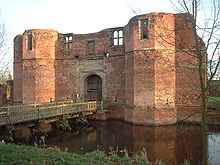Castles of England/Tudor Castles
History of the Period
[edit | edit source]This period begins with the seizure of the throne from Richard II by Henry IV. Henry was to spend most of his reign fighting to establish his hold on the country; his son, Henry V, gained the benefits inheriting a strong enough position to allow him to invade France. He won a famous victory at Agincourt and was declared the heir to the throne of France only to die shortly afterwards from dysentery.
Henry's son, Henry VI, was only one year old when his father died and inherited the thrones of England and France. But Henry was not the warrior his illustrious father was and he was to lose the throne of France bringing the Hundred Years War to an end. Whilst he reigned, an ongoing struggle took place between the Lancastrians and Yorkists. This war, the War of the Roses, ended in 1485 with the defeat of Richard III by Henry Tudor, the future Henry VII.
Castle construction was relatively rare during the Tudor period. The era of siege warfare was coming to an end, and castles had not played a major role in the War of the Roses. A typical castle of the period is closer to a fortified manor house than a true castle. However, some true castles were still built, this period seeing the rise of the brick built castle.
Brick Built Castles
[edit | edit source]
Brick making was introduced into England in the 14th century, although the Romans had used bricks the art had died out. Wealthy castles owners, in particular those in the south-east of England, began to use bricks in their castle construction. The bricks were laid using a technique now known as English Bond. This technique involves laying rows of bricks alternating between stretchers (the longer side is exposed) and headers (the shorter side is exposed). It is the strongest bond for a one brick thick wall.
Castles of the Period
[edit | edit source]Herstmonceux Castle
[edit | edit source]Herstmonceux Castle in East Sussex was built by Roger de Fiennes, Treasurer of the Household to Henry VI. Construction began in about 1441, the castle being built from Flemish brick. Although it is a superficially strong castle, with a large gatehouse and towers, the walls were too thin to resist a serious attack. It was primarily a private residence, set in large Elizabethan gardens. The castle fell into disrepair and was renovated with some modifications in the 20th century.
Kirby Muxloe Castle
[edit | edit source]
Typical for the period, Kirby Muxloe Castle is more of a fortified house than a true castle. Its large glazed windows and thin walls would not have been able to resist a determined attack for long. In the 1480s, when its construction was begun by Lord Hastings, the country was relatively peaceful and defense was only required against small bands of roving marauders.
The castle is of brick construction in a quadrangle layout. The original design included corner towers linked by curtain walls with towers placed in the middle of each length of wall. A moat surrounds the castle with a wooden drawbridge giving access to the gatehouse.